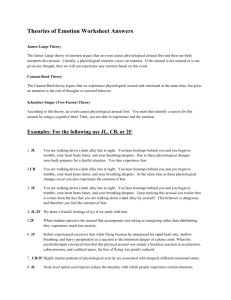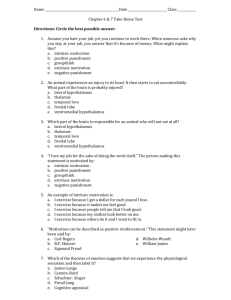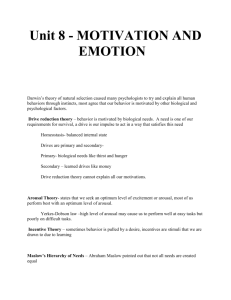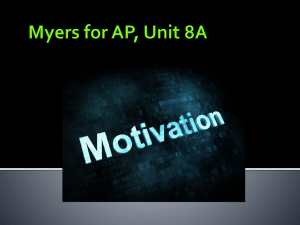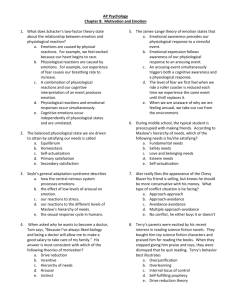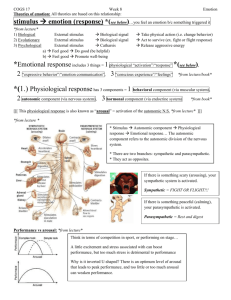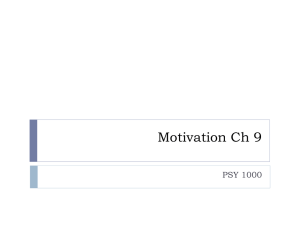4 psych theories on emotion
advertisement
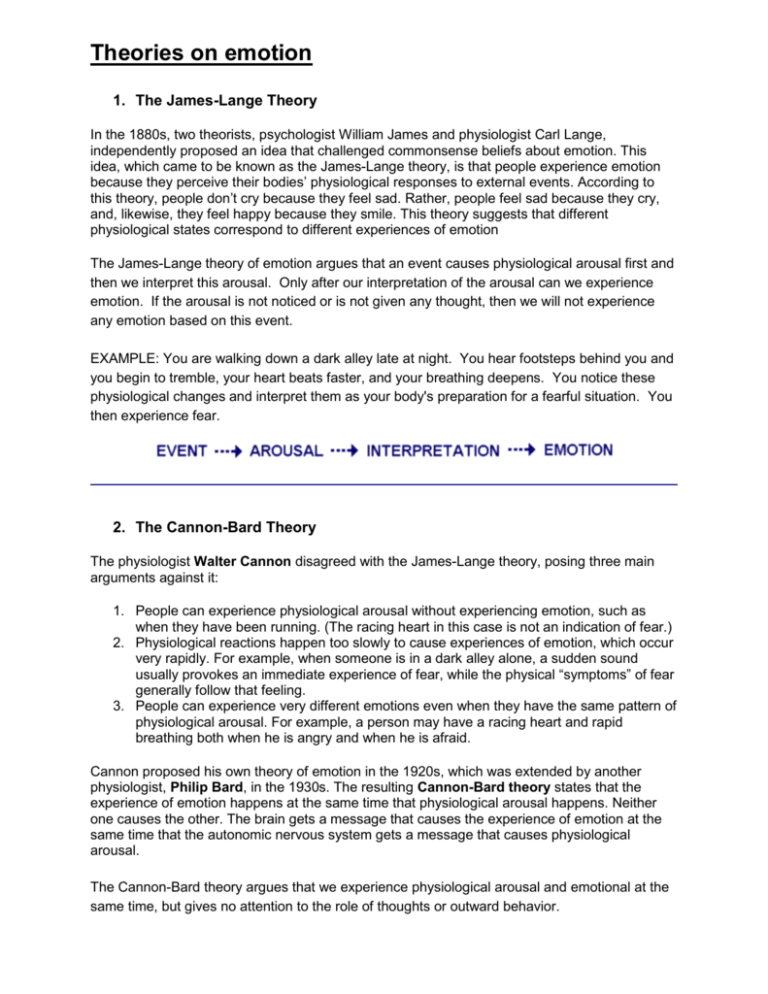
Theories on emotion 1. The James-Lange Theory In the 1880s, two theorists, psychologist William James and physiologist Carl Lange, independently proposed an idea that challenged commonsense beliefs about emotion. This idea, which came to be known as the James-Lange theory, is that people experience emotion because they perceive their bodies’ physiological responses to external events. According to this theory, people don’t cry because they feel sad. Rather, people feel sad because they cry, and, likewise, they feel happy because they smile. This theory suggests that different physiological states correspond to different experiences of emotion The James-Lange theory of emotion argues that an event causes physiological arousal first and then we interpret this arousal. Only after our interpretation of the arousal can we experience emotion. If the arousal is not noticed or is not given any thought, then we will not experience any emotion based on this event. EXAMPLE: You are walking down a dark alley late at night. You hear footsteps behind you and you begin to tremble, your heart beats faster, and your breathing deepens. You notice these physiological changes and interpret them as your body's preparation for a fearful situation. You then experience fear. 2. The Cannon-Bard Theory The physiologist Walter Cannon disagreed with the James-Lange theory, posing three main arguments against it: 1. People can experience physiological arousal without experiencing emotion, such as when they have been running. (The racing heart in this case is not an indication of fear.) 2. Physiological reactions happen too slowly to cause experiences of emotion, which occur very rapidly. For example, when someone is in a dark alley alone, a sudden sound usually provokes an immediate experience of fear, while the physical “symptoms” of fear generally follow that feeling. 3. People can experience very different emotions even when they have the same pattern of physiological arousal. For example, a person may have a racing heart and rapid breathing both when he is angry and when he is afraid. Cannon proposed his own theory of emotion in the 1920s, which was extended by another physiologist, Philip Bard, in the 1930s. The resulting Cannon-Bard theory states that the experience of emotion happens at the same time that physiological arousal happens. Neither one causes the other. The brain gets a message that causes the experience of emotion at the same time that the autonomic nervous system gets a message that causes physiological arousal. The Cannon-Bard theory argues that we experience physiological arousal and emotional at the same time, but gives no attention to the role of thoughts or outward behavior. EXAMPLE: You are walking down a dark alley late at night. You hear footsteps behind you and you begin to tremble, your heart beats faster, and your breathing deepens. At the same time as these physiological changes occur you also experience the emotion of fear. 3.Schachter and Singer’s Two-Factor Theory In the 1960s, Stanley Schachter and Jerome Singer proposed a different theory to explain emotion. They said that people’s experience of emotion depends on two factors: physiological arousal and the cognitive interpretation of that arousal. When people perceive physiological symptoms of arousal, they look for an environmental explanation of this arousal. The label people give an emotion depends on what they find in their environment. Example: If a person finds herself near an angry mob of people when she is physiologically aroused, she might label that arousal “anger.” On the other hand, if she experiences the same pattern of physiological arousal at a music concert, she might label the arousal “excitement.” According to this theory, an event causes physiological arousal first. You must then identify a reason for this arousal and then you are able to experience and label the emotion. EXAMPLE: You are walking down a dark alley late at night. You hear footsteps behind you and you begin to tremble, your heart beats faster, and your breathing deepens. Upon noticing this arousal you realize that is comes from the fact that you are walking down a dark alley by yourself. This behavior is dangerous and therefore you feel the emotion of fear. 4. Lazarus Theory The psychologist Richard Lazarus’s research has shown that people’s experience of emotion depends on the way they appraise or evaluate the events around them. Example: If Tracy is driving on a winding road by the edge of a high cliff, she may be concerned about the danger of the road. Her passenger, on the other hand, thinks about the beauty of the view. Tracy will probably feel frightened, while her passenger may feel exhilarated. Lazarus Theory states that a thought must come before any emotion or physiological arousal. In other words, you must first think about your situation before you can experience an emotion. EXAMPLE: You are walking down a dark alley late at night. You hear footsteps behind you and you think it may be a mugger so you begin to tremble, your heart beats faster, and your breathing deepens and at the same time experience fear.
